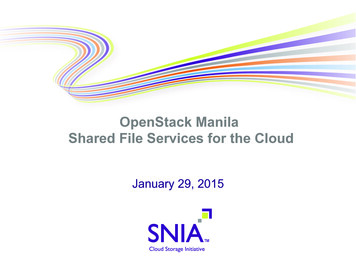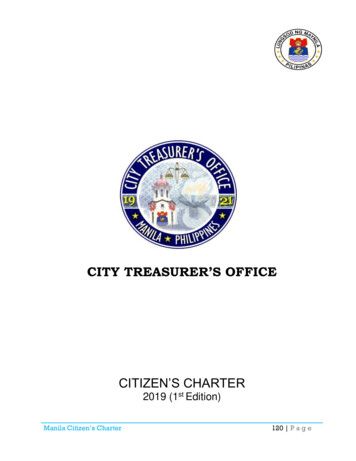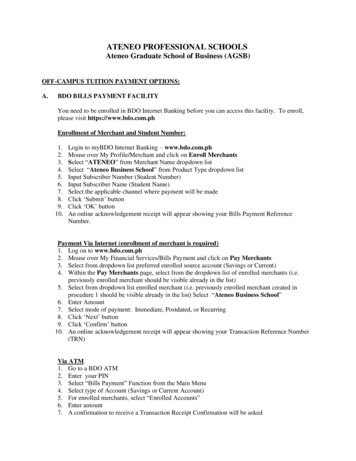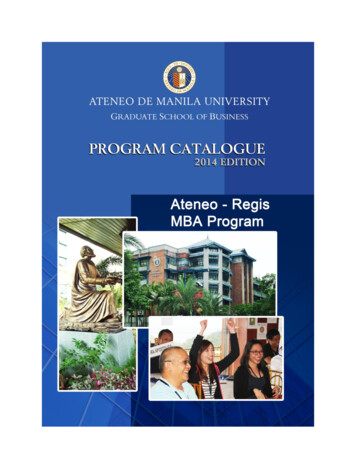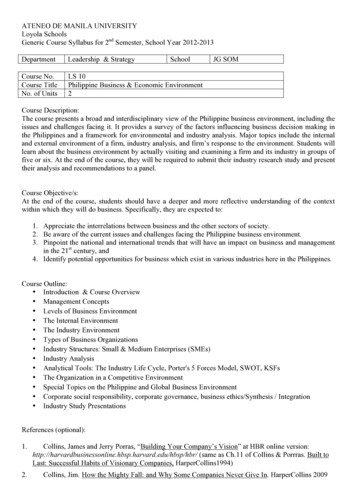
Transcription
ATENEO DE MANILA UNIVERSITYLoyola SchoolsGeneric Course Syllabus for 2nd Semester, School Year 2012-2013DepartmentLeadership & StrategySchoolCourse No.Course TitleNo. of UnitsLS 10Philippine Business & Economic Environment2JG SOMCourse Description:The course presents a broad and interdisciplinary view of the Philippine business environment, including theissues and challenges facing it. It provides a survey of the factors influencing business decision making inthe Philippines and a framework for environmental and industry analysis. Major topics include the internaland external environment of a firm, industry analysis, and firm’s response to the environment. Students willlearn about the business environment by actually visiting and examining a firm and its industry in groups offive or six. At the end of the course, they will be required to submit their industry research study and presenttheir analysis and recommendations to a panel.Course Objective/s:At the end of the course, students should have a deeper and more reflective understanding of the contextwithin which they will do business. Specifically, they are expected to:1. Appreciate the interrelations between business and the other sectors of society.2. Be aware of the current issues and challenges facing the Philippine business environment.3. Pinpoint the national and international trends that will have an impact on business and managementin the 21st century, and4. Identify potential opportunities for business which exist in various industries here in the Philippines.Course Outline: Introduction & Course Overview Management Concepts Levels of Business Environment The Internal Environment The Industry Environment Types of Business Organizations Industry Structures: Small & Medium Enterprises (SMEs) Industry Analysis Analytical Tools: The Industry Life Cycle, Porter's 5 Forces Model, SWOT, KSFs The Organization in a Competitive Environment Special Topics on the Philippine and Global Business Environment Corporate social responsibility, corporate governance, business ethics/Synthesis / Integration Industry Study PresentationsReferences (optional):1.Collins, James and Jerry Porras, “Building Your Company’s Vision” at HBR online edu/hbsp/hbr/ (same as Ch.11 of Collins & Porrras. Built toLast: Successful Habits of Visionary Companies, HarperCollins1994)2.Collins, Jim. How the Mighty Fall: and Why Some Companies Never Give In. HarperCollins 2009
3.Drucker, Peter F. The Essential Drucker. Butterworth-Heinemann. 2001. Chapters 1-3.4.Friedman, Thomas L. Hot, Flat, and Crowded. Farrar, Straus and Giroux. New York 2008.5.Friedman, Thomas L. The World is Flat. Farrar, Straus and Giroux. New York 2006.6.Magretta, Joan. Understanding Michael Porter: The Essential Guide to Competition and Strategy.Harvard Business Press Dec. 2011.7.Maital, Shlomo. Executive Economics: Ten Essential Tools for Managers. New York. The FreePress. 1994. [HD30.22 M34] Chapter 10: Economics of Cooperation.8.McCoy, Alfred W. “An Anarchy of Families: The Historiography of State and Family in thePhilippines” and “Rent-Seeking Families and the Philippine State: A History of the Lopez Family.” AnAnarchy of Families: State and Family in the Philippines, Ateneo de Manila University Press 1994., Ch.1 & 109.Palmer, Adrian & Bob Hartley. The Business Environment. Mc Graw Hill, 2002.Chapters 3, 4 & 6.10.Poblador, Niceto S., Strategy Desynthesized, Management Association of the Philippines, 200611.Porter, Michael E. The Five Competitive Forces that Shape Strategy. Harvard Business Review 200812.Robbins, Stephen P. and Mary Coulter, Introduction to Management, 10th Edition. PearsonEducation, 2007.ATENEO DE MANILA UNIVERSITY
Loyola SchoolsGeneric Course Syllabus for 2nd Semester, School Year 2012-2013DepartmentLeadership & StrategyCourse No.Course TitleNo. of UnitsLS 100Organizational Behavior3SchoolJG SOMCourse Description:Organizational Behavior (OB) is a field of study that focuses on three primary determinants of behavior inorganizations: (a) the individual, (b) groups, and (c) structure. The goal is to make organizations performmore effectively and efficiently in a sustainable manner. Robbins and Judge argued that core topics in OBinclude “motivation, leader behavior and power, interpersonal communication, group structure andprocesses, learning, attitude development and perception, change processes, conflict, work design, and workstress”Course Objective/s: acquire a deeper understanding of your character, personality, and strengths as well as yourmission, vision, and values through conversations, reflection, and assessments; experience working together in groups and teams towards developing job-relevant skills:conceptual, human, and technical; explain the OB model and basic principles of leading and managing, including ethical norms, thataffect organizational behavior; analyze the dynamics of effective people engagement as a source of sustainable competitiveadvantage; and imbibe the “whole person in a whole job” philosophy as an integral part of the design structureCourse Outline: What is organizational behavior? Diversity in organizations Attitudes and job satisfaction Emotions and moods Personality and values Perception and individual decision-making Motivation: from concepts to applications Foundations of group behavior Understanding work teams Communication Leadership Power and politics Conflict and negotiation Foundations of organization structure Organizational culture Human resource policies and practices Organizational change and stress management Convergence lecture: organizational leadership success stories
References (optional):Barker, J. A. (1992). Future edge. New York: William Morrow and Company.Covey, S. (1998). The 7 habits of highly effective teens. New York: Simon Schuster.Covey, S. R. (1991). Principle-centered leadership, New York: Summit Books.De Leon, E. B. (1998). Live, love, laugh forever. Manila: National Book Store Publishing.Frick, D. M, & Spears, L. C. (Eds.) (1996). On becoming a servant leader: The private writings of Robert K.Greenleaf. San Francisco: Jossey-Bass.Greenleaf, R. K. (2002). Servant leadership: A journey into the nature of legitimate power & greatness.Mahwah, NJ: Paulist Press.Spears, L. C. (Ed.) (1998). The power of servant leadership. San Francisco: Berrett-Koehler.Kouzes, J. M., & Posner, B. Z., (2007). The leadership challenge (4th ed). Jossey-Bass.Lowney, C. (2003). Heroic leadership: Best practices from a 450-year-old company that changed theworld. Chicago:ILL: Loyola Press.Maxwell, J. (1998). The 21 Irrefutable laws of leadership: Follow them and people will follow you.Nashville, TN: Thomas Nelson.Matthews, A. (1997). Follow your heart. Queensland, Australia: Seashell Publishers.United Nations (2000). Good Governance. New York: UN PublishingATENEO DE MANILA UNIVERSITYLoyola Schools
Generic Course Syllabus for 2nd Semester, School Year 2012-2013DepartmentLeadership & StrategyCourse No.Course TitleNo. of UnitsLS 125Strategic Management3SchoolJG SOMCourse Description:Strategic Management (LS 125) serves as an integrative course for seniors in management-orientedconcentrations, particularly the ME, ComTech, and SOMBA programs. The course concentrates on therudiments of strategic management. It is a big picture course that integrates the different functional areas tochart the future directions of different organizations. It focuses on the firm – the industry and thecompetitive environment in which it operates, its long-term direction and strategy, its resources andcompetitive capabilities, and its prospects for success. The course project is a corporate strategic audit,which is a hands-on experience for students in strategy evaluation, (re)formulation, and implementationplanning.Course Objective/s:1. To teach students the process of strategic management; formulation-implementation-evaluation; andthe underlying concepts, steps, and sub-processes involved in each stage.2. To develop students’ capability to think strategically about a company; its present business position,its long-term directions, its resources and competitive capabilities, its opportunities for gainingsustained competitive advantage, its competitive environment, and its strategic options.3. To build skills in conducting strategic analysis in a variety of industries and competitive situations.4. To identify the competitive challenges of a global market environment.5. To provide hands-on experience in crafting business strategy, reasoning carefully about strategicoptions using what-if analysis to evaluate various alternatives, and making focused strategicdecisions.Course Outline: The Nature of Strategic Management The Business Vision and Mission The External Assessment The Internal Assessment Establishing Objectives Developing Strategies into Action Generating Strategic Options Strategy Analysis and Choice Dealing with Management & Operations Issues Dealing with Marketing, Finance/Accounting, R&D and MIS Issues Business Ethics/Social Responsibility/Environmental Sustainability Strategy Review, Evaluation and Control Corporate Strategic Audit Final Panel PresentationsReferences (optional):David, Fred R. Strategic Management: Concepts and Cases. Global Edition. Prentice Hall-Pearson (13TthLow Price Edition). 2011
Hill, Charles W. L. and Gareth R. Jones. Theory of Strategic Management with cases. Canada.Southwestern (9th International Student edition) 2010Pitts, Robert A and David Lei: Strategic Management: Building and Sustaining Competitive Advantage.Thomson Asian (4th) Edition 2007. http://pitts.swlearning.comThompson and Strickland. Strategic Management: Concepts and Cases (13th Ed.)ATENEO DE MANILA UNIVERSITYLoyola SchoolsGeneric Course Syllabus for 2nd Semester, School Year 2012-2013
DepartmentLeadership & StrategyCourse No.Course TitleNo. of UnitsLS 126Strategy Formulation3SchoolJG SOMCourse Description:Strategy Formulation (LS 126) and Strategy Implementation (LS 127) serve as the capstone, integrativecourses for graduating seniors in management-oriented concentrations. Students will draw from conceptstaken in previous courses such as accounting, finance, marketing, production, human resources, orinformation systems to assess the industry and competitive environment of a firm, its resources andcompetitive capabilities, its prospects for success, and ultimately, determine its long-term direction andstrategy,This course focuses on the development of a business plan. Major topics covered are: The StrategicManagement Process; Mapping the Business Landscape; Creating Competitive Advantage; StrategyAnalysis and Choice.Course Objective/s:1. To learn, understand, and appreciate the process of strategic management – strategy formulation,strategy implementation, and strategy evaluation. In the learning process, students should develop thecapability to think strategically about an organization by:a. conducting strategic analysis in a variety of industries and competitive situations whether small orlarge, startup or ongoing, local or global;b. integrating the knowledge gained in earlier management courses and demonstrating why and how thedifferent parts of the business need to be managed in strategic harmony for the organization tooperate in a winning fashion;c. developing managerial judgment in assessing business risk and improving the ability to make sounddecisions and achieve effective outcomes.2. To be aware of the importance of exemplary ethical principles, sound personal and company values, andsocially responsible management practices.Course Outline: The Nature of Strategic Management The Business Vision and Mission The External Assessment The Internal Assessment Establishing Objectives Developing Strategies into Action Generating Strategic Options Strategy Analysis and Choice Dealing with Management & Operations Issues Dealing with Marketing, Finance/Accounting, R&D and MIS Issues Business Ethics/Social Responsibility/Environmental Sustainability Strategy Review, Evaluation and Control Business Plan Final Panel vid and http://www.strategyclub.com
Supplementary Textbooks/Readings:1. Hill, Charles W. L. and Gareth R. Jones. Theory of Strategic Management with Cases. Canada. SouthWestern (8th International Student Edition) 2009.2. Pitts, Robert A and David Lei. Strategic Management:Building and Sustaining Competitive Advantage.Thomson Asian (4th) Edition 2007. http://pitts.swlearning.com3. Thompson, Strickland and Gamble. Crafting and Executing Strategy. McGraw Hill 16th Edition. 2007.4. Zimmerer, Thomas W. and Norman M. Scarborough. Essentials of Entrepreneurship & Small BusinessManagement. Prentice-Hall 2008.5. Kaplan, Robert S. and David P. Norton. The Balanced Scorecard: Measures that Drive Performance.HBR Onpoint Enhanced Edition 2009.6. Kaplan, Robert S. and David P. Norton. Using the Balanced Scorecard as a Strategic ManagementSystem. HBR Classic 2009.ATENEO DE MANILA UNIVERSITYLoyola SchoolsGeneric Course Syllabus for 2nd Semester, School Year 2012-2013
DepartmentLeadership & StrategyCourse No.Course TitleNo. of UnitsLS 127Strategy Implementation3SchoolJG SOMCourse Description:This course is a continuation of Strategy Formulation (LS 126) which is done during the first semester.Students implement the group business project developed during the first semester for at least 3 months,evaluate their performance and strategies, and show how they can make the business grow. Major topicscovered include Implementing Strategies: Management and Functional Issues; Review, Evaluation andControl. Case studies and readings complement conceptual content.Course Objective/s:1. To foster an entrepreneurial mindset and develop strategic competencies by providing hands-onexperience in crafting business strategy, reasoning carefully about strategic options, using what-ifanalysis to evaluate various alternatives, making focused strategic decisions, and actually implementingand executing such decisions.2. To acquaint you with the managerial tasks associated with implementing and executing companystrategies, drill you in the range of actions managers can take to promote competent strategy execution,and give you some confidence in being able to function effectively as part of a company’s strategyimplementing team.3. To emphasize the importance of exemplary ethical principles, sound personal and company values, andsocially responsible management practices.Course Outline: Review of Group Business Plan Implementation Business Project Status Reports Corporate Strategic Audit Strategy Implementation Report Panel PresentationsReferences (optional):David, Fred R. Strategic Management: Concepts and Cases (13th Low Price 2011 Edition)http://www.prenhall.com/david and http://www.strategyclub.comSupplementary Textbooks/Readings:1. Hill, Charles W. L. and Gareth R. Jones. Theory of Strategic Management with Cases. Canada. SouthWestern (8th International Student Edition) 2009.2. Pitts, Robert A and David Lei. Strategic Management:Building and Sustaining Competitive Advantage.Thomson Asian (4th) Edition 2007. http://pitts.swlearning.com3. Thompson, Strickland and Gamble. Crafting and Executing Strategy. McGraw Hill 16th Edition. 2007.4. Zimmerer, Thomas W. and Norman M. Scarborough. Essentials of Entrepreneurship & Small BusinessManagement. Prentice-Hall 2008.5. Kaplan, Robert S. and David P. Norton. The Balanced Scorecard: Measures that Drive Performance.HBR Onpoint Enhanced Edition 2009.6. Kaplan, Robert S. and David P. Norton. Using the Balanced Scorecard as a Strategic ManagementSystem. HBR Classic 2009.
ATENEO DE MANILA UNIVERSITYLoyola SchoolsGeneric Course Syllabus for 2nd Semester, School Year 2012-2013
DepartmentLeadership & StrategyCourse No.Course TitleNo. of UnitsLS 128Small Business Consulting3SchoolJG SOMCourse Description:Small Business Consulting is a course designed to prepare students for professional consulting work. SmallBusiness Consulting or simply “Business Consulting” for small and medium enterprises provides studentswith the necessary skills in understanding industry structures, the value creation process in enterprises,innovative business modeling and formulating action programs based on internal business processes. Theseinternal business processes are classified under four structures – operations management, customermanagement, innovation, and regulatory and social involvement.Course Objective/s: To prepare students for professional consulting work To enable the students to understand the various consulting environments in small and mediumenterprises To provide students with hand on experience in consulting work To train students in business model design and innovationCourse Outline: Organize consulting teams Getting a Client Business Information Sources Project Management Structural Analysis and Value Chain Analysis Business Strategies Strategy Maps and the Balanced Scorecard The Business Process and Diagram/Management Consulting Management Consulting / Case Discussion The McKinsey Way Competing for the Future and Value Migration How you can drive revenue and profit growth with Innovation Solution-Focused Coaching Philippine Business Environment Course Summary – Why be a Consultant? Putting up your own consulting businessReferences (optional):Greene, Jane and Grant, Anthony M. Solution-Focused Coaching ( GreatBritain: Henry Ling Ltd, Dorchester, 2003 )Kaplan, Robert S. and Norton, David P. The Balanced Scorecard ( Boston: Harvard Business School Press,1996 )Kaplan, Robert S. and Norton, David P. Strategy Maps ( Boston: Harvard Business School Press, 2004)
Kubr, Milan. Management Consulting (Geneva: International Labour Organization, 1986)Lafley A. G. and Charan, Ram. Game-Changer (New York: Crown Business, 2008)Maister, David H. Managing the Professional Service Firm (New York: Press, 1993)Porter, Michael E. Competitive Strategy (New York: Free Press, 1980)Porter, Michael E. Competitive Advantage (New York: Free Press, 1985)Hamel, Gary and Pralahad, C.K. Competing for the Future (Boston: Harvard Business School Press, 1994)Rasiel, Ethan M. The McKinsey Way (New York: McGraw-Hill, 1999)Roberts, Paul. Guide to Project Management (London: Profile Books Ltd, 2007)Slywotzky, Adrian J. Value Migration (Boston: Harvard Business School Press, 1996)ATENEO DE MANILA UNIVERSITYLoyola SchoolsGeneric Course Syllabus for 2nd Semester, School Year 2012-2013
DepartmentLeadership & StrategyCourse No.Course TitleNo. of UnitsLS 130Leadership in the 21st Century3SchoolJG SOMCourse Description:Our course aims to introduce the different types and styles of leadership and prepare students for their futureroles as managers in their respective organizations and communitiesCourse Objective/s:At the end of the course, the student will be expected to have:1.Learned the of evolution of the leadership patterns in relation to the country’s phase in thedevelopment of civilization: the agricultural, industrial and the post-capitalist;2.Examined assumptions on leadership and followership in relation to their relevance given thechanges that have occurred in contemporary society;3.Discovered their own leadership styles;4.Determined whether leaders are made or born, and how leaders can be effective in industry and ingovernment and non-profit organizations;5.Distinguished between leaders and managers;6.Differentiated between creating from problem solving7.Experienced the interconnection of leadership and community-making;8.Learned from the great models of leadership in the world;9.Been exposed to different leadership patterns, with emphasis on servant leadership;10.Applied what they had learned from their readings, research, interviews with selected leaders in thecommunity;11.Assimilated concepts and practices taken up during the class discussions;12.Developed a paradigm shift towards an awareness and commitment to a real world-class leadershipand followership relevant to the needs and aspirations of the 21st Century.Course Outline: Course Orientation, & Leveling of Expectations Paradigm-Shifting for 21st Century Leadership Definitions of Leadership The 21 Indispensable Qualities of A Leader Leadership Questions What Leaders Really Do Leadership Myths & Realities The Leadership Challenge The 21 Irrefutable Law of Leadership Leadership & The One Minute Manager Discussions on Emotional Intelligence Servant Leadership Heroic Leadership Challenges on the 21st Century Seven Faces of Leadership The Heart of Change Seven Habits of Highly Effective People
ATENEO DE MANILA UNIVERSITYLoyola SchoolsGeneric Course Syllabus for 2nd Semester, School Year 2012-2013DepartmentLeadership & StrategySchoolJG SOM
Course No.Course TitleNo. of UnitsLS 135Strategic Human Capital Management3Course Description:Money, materials, machines and men are considered critical resources of a nation and of organizations. TheStrategic Human Resources Management (SHRM) course posits that money, materials and machines aremeaningless without the wise use of the single most critical component of productivity: PEOPLE. Thiscourse introduces the strategic perspective to be taken in harnessing the human resources of an organization.More particularly, the course focuses on the strategic roles which the Human Resources function andprofessionals play in creating value and delivering results to their respective organizations.Course Objective/s:At the end of this course, students are expected to: Identify means of managing people in a way that leads to optimal accumulation of human capital. Analyze and link the measurement of human capital to business performance metrics. Develop strategic initiatives to identify aspects of human capital management as drivers of businesssuccess.Course Outline: Introduction to Human Resource Management The Manager’s Role in Strategic Human Resource Management Job Analysis Personnel Planning and Recruiting Employee Testing and Selection Interviewing Candidates Training and Developing Employees Performance Management and Appraisal Coaching, Careers, and Talent Management Establishing Strategic Pay Plans Pay for Performance and Financial Incentives Benefits and Services Ethics, Justice and Fair Treatment in HR Management Labor Relations and Collective Bargaining Employee Safety and Health Managing Global Human Resources Managing Human Resources in Entrepreneurial FirmsATENEO DE MANILA UNIVERSITYLoyola SchoolsGeneric Course Syllabus for 2nd Semester, School Year 2012-2013DepartmentLeadership & StrategyCourse No.LS 136SchoolJG SOM
Course TitleNo. of UnitsStrategic Human Resource Development3Course Description:This senior elective course provides the students with a basic yet comprehensive overview on how peopleare developed in organizations to be efficient and effective resources. In order to do so, it first gives abriefing on the Human Resource function, and how Human Resource Development fits into the picture.The course provides concepts, tools, models, and practical insights for the development of an individual, ofthe team, and of the organization as a whole. It equips students with skills on assessing and identifyingdevelopment needs, and customizing the intervention to address said needs effectively. While seeking tounderstand the above, the course simultaneously develops students on personal areas of development theythemselves will identify. As such, students taking the course will wear two hats interchangeably – that of adeveloper, and that of one being developedCourse Objective/s:At the end of this Course, the student should be able to: Assess and identify development areas of an individual, team, and, organization Design and implement interventions suitable for addressing identified development needs Achieve development goals he has set for himself at the start of the semesterCourse Outline: The Human Resource (HR) Function The Human Resource Development Function within HR Evaluating and Identifying Individual, Team, and Organization Development Needs Individual Development Team Development Organization DevelopmentATENEO DE MANILA UNIVERSITYLoyola SchoolsGeneric Course Syllabus for 2nd Semester, School Year 2012-2013DepartmentLeadership & StrategyCourse No.LS 137SchoolJG SOM
Course TitleNo. of UnitsOrganizational Development3Course Description:Organization Development (OD) is an area of practice and research in Human Resource Development(HRD). OD attempts to bring about change in the different levels of the organization (the individual, groupand organization) using a wide variety of interventions. In this course, theoretical models and the process ofOD will be discussed. Students will also learn how to improve individual, group/team and organizationalperformance through the use of OD techniques or interventions like group dynamics, training, culturechange, and work-life balanceCourse Objective/s:To enable the students to: understand the philosophical, historical, theoretical, political and practical underpinnings of OD as a corearea of practice within HRD increase awareness of different tools that are used to diagnose organizations as well as interventions usedthrough hands-on experience enhance skills in facilitation, OD skills, group process, communication, and collaborationCourse Outline: General introduction to organization development The nature of planned change The od practioner Entering and contracting Diagnosing organizations Diagnosing groups and jobs Collecting and analyzing diagnostic information Feeding back diagnostic information Designing interventions Interpersonal and group process approaches Organization process approaches Restructuring organizations Employee involvement Work design Performance management Developing talent Managing workforce diversity and wellness Transformational changeReferences (optional):Cummings, T. G. & Worley, C. G. (2009).Organization development and change (9th edition).Canada:South-Western Cengage LearningBanks, B.B. & Alban, B. T. (2006) The handbook of large group methods: creating systemic change inorganizations and communities. San Francisco: Jossey-Bass.Beer, M and Hohria, N.(Eds).(2000)Breaking the code of change. Boston, MA: Harvard Business SchoolPress.Bradford, D.L. &Burke, W. W. (2005). Reinventing organization development: New approaches to changein organizations. Californina: Pfeiffer.
Brown, D. R. (2011). An experiential approach to organizational development. (8th ed). New Jersey:Pearson Education, Inc.De Guia, F. (2000). Culture change: key to organization development: A success story. Makati City:Florence de Guia & Associates.Fullan, M. (2007). Leading in a culture of change. San Francisco, CA: John Wiley & Sons, Inc.Fullan, M., & Ballew, A. C. (2004). Leading in a culture of change personal action guide and workbook.San Francisco, CA: John Wiley & Sons, Inc.Gallos, J. V. (Ed) (2006)Organization development: A Jossey-Bass Reader. San Francisco: Jossey-Bass.Harrison, M. I. (2005). Diagnosing organizations: methods, models and processes. (3rded). California: SagePublications.Hechanova, M. R. M. & Franco, E. P. (2008) Leading Philippine organizationsin a changing world:Research and best practices. Quezon City: Ateneo de Manila University Press.Jones, B. B. and Brazzel, M., Eds (2006) The NTL handbook of organization development and change:principles, practices, and perspectives. San Francisco: PfeifferJohnson, S. (2002). Who moved my cheese? United Kingdom: VermilionKotter, J. (1990). A force for change: How leadership differs from management. New York, NY: TheFree Press.Kotter, J. (1996). Leading change. Boston, MA: Harvard Business School Press.Sjoholm F. &Tongzon, J. (Eds.) (2005).Institutional change in Southeast Asia.London: RoutledgeCurzon.ATENEO DE MANILA UNIVERSITYLoyola SchoolsGeneric Course Syllabus for 2nd Semester, School Year 2012-2013DepartmentLeadership & StrategySchoolCourse No.Course TitleLS 138Creative Problem Solving & Decision MakingJG SOM
No. of Units3Course Description:This course helps students develop creative problem solving skills necessary not only for careers in bigcorporations but also for in starting businesses.Course Objective/s:The end of the course, the student should be able to:1.2.3.4.5.6.Exhibit passion in scanning the environment.Diagnose individual problem solving and decision-making style.Identify and articulate problems clearly.Analyze problems using a multi-stakeholder and cross-functional approach.Generate new ideas individually and with groups to arrive at decisions and solutions.Create a business proposal.Course Outline:What is Problem-Solving and Decision-makingLearning ApproachesWhole-Brain TechniquesSystems ThinkingProblem IdentificationProblem Solving Technique: A ModelCreativity and InnovationGenerating ideasWorking with GroupsWill it Fly? Evaluating the Good IdeaReferences (optional):1. Oech, Roger von. A Whack on the Side of the Head (1990). New York, USA. Warner Books, Inc. 1990(chapters required)2. Managing Creativity and Innovation. USA. Harvard Business School Publishing Corp.ATENEO DE MANILA UNIVERSITYLoyola SchoolsGeneric Course Syllabus for 2nd Semester, School Year 2012-2013DepartmentLeadership & StrategyCourse No.Course TitleLS 142Cross Cultural CommunicationsSchoolJG SOM
No. of Units3Course Description:This course focuses on how cultural differences—at the regional, national, corporate and functional levels--influence business work-styles and protocol, particularly communication, and how cross-cultural literacybecomes a key factor in a diverse and globalised workplace. Theories and concepts on country andcorporate cultures are complemented by real-life cases, anecdotal evidence and primary student research.
Generic Course Syllabus for 2nd Semester, School Year 2012-2013 Department Leadership & Strategy School JG SOM Course No. LS 10 Course Title Philippine Business & Economic Environment No. of Units 2 Course Description: The course presents a broad and interdisciplinary view of the Philippine business environment, including the

